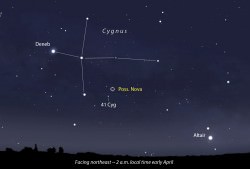Have you ever heard that meme, “When looking at stars, you’re actually looking into the past. Many of the stars we see at night have already died.” Is this true?
While you’re flipping through your Pinterest collection of cat-based inspirational posters, you might come across the saying, “When looking at stars, you’re actually looking into the past. Many of the stars we see at night have already died. Like your dreams.”
Aww, that’s mean and sad. But is it true, Squidward? Are all these beautiful stars in our night sky long gone? Like our dreams?
Light travels at about 300,000 km/s, which is incredibly fast. Stars are so far away, even light from the closest stars will take years to get to us travelling at that speed. Most of the stars we see with the naked eye are actually pretty close. The brightest in the night sky is Sirius in the constellation Canis Major. It’s only about 8.6 light years away.
Which means if you crashed a whole bunch of spaceships into it tomorrow, we here on Earth wouldn’t see it happen for almost a decade. Long after people had stopped wondering where you’d picked up all those spaceships, and why had you decided to crash them into a star instead of trading for gold pressed latinum, the spice Melange, or magical space cheese.
One of the most distant naked eye stars is Deneb in the constellation Cygnus, which is almost 3,000 light years away. The light we’re seeing from Deneb started its journey towards us when ancient Rome was just a few hamlets and not even on the map for real estate speculators.

This might seem like a really long time for those of us without immortal robot bodies, but a few thousand years is negligible to the age of a typical star, which is on the order of billions of years. So, Deneb, barring removal for an interstellar bypass, is probably still there.
There are a few stars that could possibly explode in the near future, such as the red giant star Betelgeuse in the constellation of Orion.
It’s about 650 light years away, if it had exploded a couple centuries ago, we still wouldn’t know. There are a few galaxies that can be seen with the naked eye, such as Andromeda, which is about 2.5 million light years away. Given that Andromeda has somewhere between 200 and 400 billion stars, it is almost certain that some of them have exploded in the last 2 and a half million years. But the vast majority of them have are still there, twinkling away.
So it is possible that you could look up in the night sky and see a “dead” star, but almost all of the stars you see are perfectly active main-sequence stars, and will be for quite some time. Telescopes allow us to see much further out into space, billions of light years away. Given that a star like our Sun has a lifetime of about 10 billion years, many stars in most of the distant galaxies we observe died long ago.

But don’t be sad, we’re not running out of stars. Because of this huge passage of time, it means many new stars have been born, and we just aren’t able to see them yet. There are some stars even in the most distant galaxies that are still around.
Smaller stars live longer than larger stars, and red dwarf stars can live for trillions of years. So when you look at the Hubble Ultra Deep Field, the most distant galaxies are around 13 billion years old, and the smaller stars in those galaxies are still shining. So don’t worry. Those stars are still there, and so are your dreams.
What do you think? If you go get a closeup look and see which stars were still around, where would you go look first? Tell us in the comments below.
And if you like what you see, come check out our Patreon page and find out how you can get these videos early while helping us bring you more great content!


Trapezium… I’d like to know how this spot in Orion has evolved / developed. There’s so much going on…
Eta Carina. All the Southern Hemisphere folk would agree I’m sure.
What about other galaxies?
ie. are some of the distant Galaxies we see at distances greater than the average main sequence life time?
The large brighter stars have the shortest lifespans.
When we see the light of another galaxy, do we mostly see the light of the larger brighter ones?